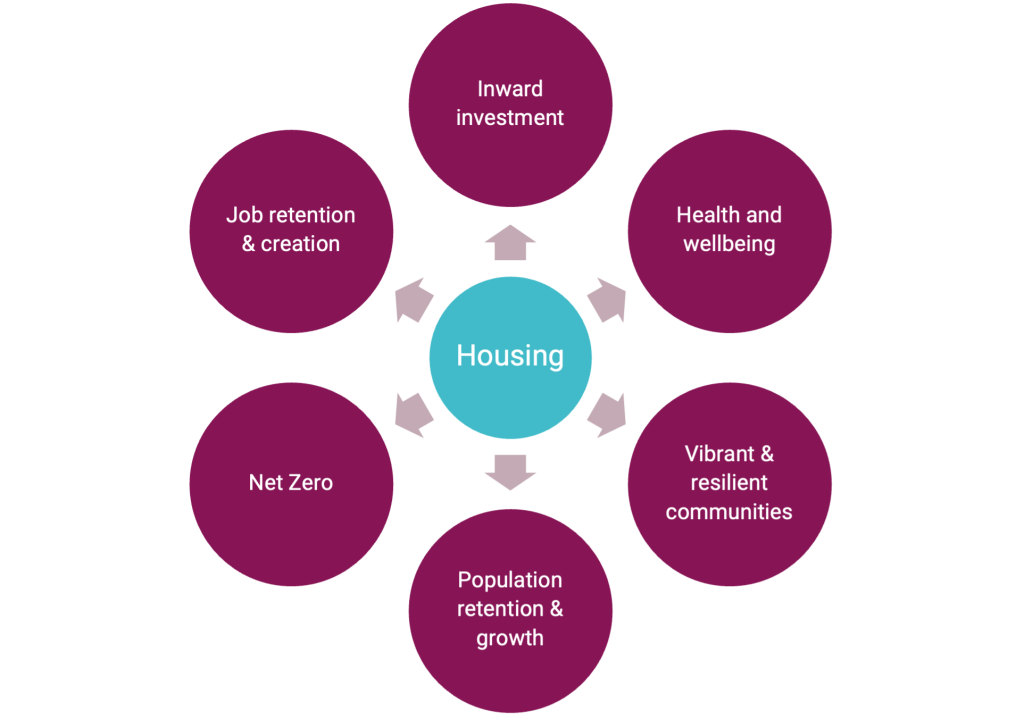
Posted 23.09.25
Are you happier now than you were a year ago? The latest data on UK wellbeing suggests that,...
1 minute read
Much of BiGGAR Economics work involves assessing the impact of economic activity, including how it can benefit wider society and the wellbeing of communities.

An increasingly common theme arising from a number of different perspectives, is housing, or more accurately – the lack of housing.
Housing affects us all – as individuals and collectively. Businesses and communities, regardless of size, are all influenced by the availability and affordability of housing.
In recent years many of us have heard of businesses and public services that cannot appoint staff due to lack of local accommodation. Our work shows this is a major concern for some sectors. Some recent studies have shown a lack of housing is not only affecting current economic performance but also future potential economic activity.
An undersupply of housing leads to higher house prices, and a range of knock-on effects that can lead to gaps in the labour market. This can affect productivity, economic growth and community resilience in various ways:

As the impact of housing on our economy and wellbeing becomes more apparent, clients are increasingly turning to BiGGAR Economics to explain and evaluate these impacts and to develop practical solutions.
Take the economy of Mull and Iona as an example. Mull and Iona Community Trust (MICT) commissioned BiGGAR Economics to look at the housing situation on the island as survey evidence suggested their economy is being severely constrained by a shortage of accommodation for workers. Our analysis confirmed the accommodation shortage is stifling economic activity on the islands by harming both the scale of business operations and productivity levels.
We also found that if the unmet demand for worker accommodation is fully addressed, then in 20 years the islands could be supporting nearly 400 more jobs and generating £20.1 million GVA/year more for the Scottish economy than they would be if no action is taken.
Perhaps even more importantly, the importance of a dynamic labour market populated by innovative and enthusiastic young people cannot be underestimated, particularly on an island. It could be a catalyst for social regeneration that could breathe new life into communities and give young people a reason to remain on the islands.
We are pleased to report that following our report Argyll and Bute Council confirmed investment of around £1.5 million on Mull for key worker accommodation – working in partnership with MICT – as part of their forthcoming £70 million Rural Growth Deal.
With an in-depth understanding of local needs, community bodies can be uniquely positioned to coordinate the delivery of housing projects
But it’s not just community bodies that have a role to play, the public sector also plays an important part.
A good illustration of this is Moray Council’s £7.5 million Housing Mix Delivery project. Part of the Moray Growth Deal, this project will see accessible, affordable and carbon conscious homes built across Moray, boosting housing supply and enhancing community wellbeing.
In 2022 we worked with the team from Moray Council to develop the full business case for this project. This involved considering the economic benefits expected to arise from providing new housing in rural towns and villages, including the benefits from bringing constrained brownfield sites back into use.
The public sector can play an important role in stimulating the delivery of new housing by helping bring constrained sites forward for development.
Finding housing to accommodate a growing workforce can be challenge for fast growing sectors. Renewable energy is no exception.
Scottish and Southern Electricity Networks Transmission (SSENT) plans to invest £7+ billion in Scotland’s energy transmission infrastructure by 2030. The provision of worker accommodation is expected to be crucial for delivering this pipeline of projects.
SSENT commissioned BiGGAR Economics to carry out an economic impact assessment of five accommodation options that could accommodate up to 450 construction workers in Peterhead.
Our study involved an evaluation of housing availability and affordability in the Aberdeenshire area and estimated the economic benefits associated with several proposed options. We considered how each would contribute to the economy of Peterhead and Aberdeenshire and found that construction and operation of an accommodation village would deliver the largest economic benefits.
Investment in local housing by growing sectors can be transformational, particularly for rural communities.
Similarly, in an assessment of potential opportunities and impacts of a major offshore wind development in the west of Scotland all stakeholders were optimistic about the development’s potential to contribute to addressing housing issues. One of our findings was that the requirement for housing could provide a transformational opportunity for many nearby communities.
Housing affects us all. What our recent experience has shown is that by working cooperatively, public, private and third sector organisations all have the potential to help tackle housing shortages.
If you would like to find out more about our work on housing or speak to us about how we can help you with your project, please get in touch at info@biggareconomics.co.uk
Posted 19.02.24
Our latest news

Posted 08.08.25
Impact of the James Hutton Institute
Economic Impact through Transformative Science The James Hutton Institute (the Hutton) is one of the world’s leading scientific...
1 minute read

Posted 22.07.25
Challenges and Opportunities in North West Scotland
BiGGAR Economics was commissioned by NorthWest2045 (NW2045) to develop a socio-economic profile for north west Scotland – identifying...
5 minute read